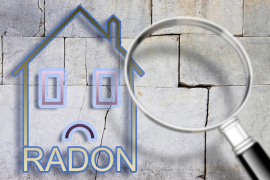
When it comes to home safety, there are certain threats that can be overlooked due to their silent and invisible nature. Radon gas can lurk beneath the surface of many homes and pose serious health risks to occupants. In this blog post, we'll explore the dangerous nature of radon gas, its potential health effects, and the importance of radon testing and mitigation in ensuring the safety of your home and family.
- Understanding Radon Gas:
Radon is a naturally occurring radioactive gas that is produced by the decay of uranium in soil, rock, and water. It is odorless, colorless, and tasteless, making it impossible to detect without specialized testing equipment. Radon can enter homes through cracks in the foundation, gaps in walls and floors, and openings around pipes and utility lines, where it can accumulate to dangerous levels.
- Health Risks of Radon Exposure:
Prolonged exposure to elevated levels of radon gas is the second leading cause of lung cancer, responsible for an estimated 21,000 deaths in the United States each year, according to the Environmental Protection Agency (EPA). Radon gas decays into radioactive particles that can become trapped in the lungs when inhaled, where they emit radiation that can damage lung tissue and increase the risk of cancer over time. Smokers and individuals with pre-existing respiratory conditions may be at even greater risk of harm from radon exposure.
- Importance of Radon Testing:
Given the serious health risks associated with radon exposure, it's crucial for homeowners to test their homes for radon regularly. The state of Minnesota recommends testing every 5 years and the EPA recommends testing every two years and taking action if levels exceed the recommended guideline of 4 picocuries per liter (4.0 pCi/L). Testing is particularly important in regions with high radon potential, (the Midwest with its agriculture being higher) although radon can be present in homes across the country.
- Mitigating Radon Gas:
If radon levels in your home are found to be elevated, it's essential to take steps to mitigate the problem and reduce radon exposure. Radon mitigation techniques typically involve sealing cracks and openings in the foundation, improving ventilation, and installing a radon mitigation system, such as a sub-slab depressurization system, which redirects radon gas from beneath the home to the outdoors, where it can safely disperse.
- Ensuring Home Safety:
Protecting your home and family from the dangers of radon gas requires proactive measures and regular testing. By raising awareness of the risks associated with radon exposure and taking steps to test and mitigate radon levels in your home, you can create a safer and healthier living environment for yourself and your loved ones.
- Radon Testing in the Home Buying and Selling Process
The general home inspection when buying a home is a popular time for radon testing. It gives buyers the opportunity to ensure radon levels are low in their new home to keep their family safe. While you can perform a radon test at any time, if you find the home you are purchasing requires a radon mitigation system, the cost of installing one can often be split between the buyer and seller.
In conclusion, radon gas poses a significant yet often overlooked threat to home safety, with the potential to cause serious health problems such as lung cancer. By understanding the dangers of radon exposure, testing your home regularly, and taking steps to mitigate radon levels as needed, you can protect your family and ensure peace of mind knowing that your home is a safe and healthy place to live. Don't let radon gas remain a silent threat in your home—take action today to safeguard your family's well-being by getting a radon test with one of our licensed inspectors in our Twin Cities or St Cloud AmeriSpec locations!